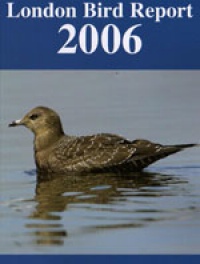London Bird Report 2006

However, picking up a copy of a bird report for an area you are unfamiliar with changes the experience somewhat. Your initials aren't there, so there's no point wasting your time thumbing through looking for them, and very few, if any, of the sightings will be birds that you tried to see and missed. It makes the whole experience of picking up the report for the first time rather refreshing and the chance to start reading through is rather exciting. And so, with an element of delving into the unknown, I picked up the London Bird Report 2006 to find out a little bit more about my new local area.
The report is a pretty standard layout as bird reports go. It's A5 in size, a little over 200 pages in length and with a rather gripping photograph of a juvenile Long-tailed Skua adorning the front cover. The print quality is certainly very good and all pages with photographs (around 80 photographs in total) are glossy. It starts with the introduction, the list of contributors and the monthly summaries, on through the systematic list of species, a review of first and last migrant dates, a ringing report from the area, finishing with a variety of short articles of which I will mention more later.
Old habits die hard, though, and I will admit that the first section I headed for was the photography section. The photographs are all of a good standard and make for interesting viewing. An added bonus, however, is the addition text below the photos; more than just species, date and location. This adds some rather nice information about the birds pictured. The biggest surprise here was finding one of my own pictures printed — something I knew nothing about until I saw it!
The text starts with an explanation of the London Recording area — an area within a 20-mile radius of St Paul's Cathedral — and is followed by a small map and a six-page list of sites with Ordnance Survey grid references. Extremely helpful for anyone not familiar with the area or any of the sites mentioned in the text. The month-by-month review of the year follows. Apart from the odd comma that seems to have gone astray, this is well written, informative but to-the-point and very readable.
The systematic list of records is pretty standard for a bird report: species, status, summary, records. It is well laid out, though, and clear and easy to read. Tables of data and graphs are also included for some species. One of my bugbears is the inclusion of graphs and data with no explanation of what it shows, as is so often the case in far too many publications, so I am pleased to say that all of the data here is explained fully. Even the numbers in parentheses within the text of each species are explained in the summary — it's shocking how many publications fail to do this and just leave you guessing! Illustrations are few and far between with only five through the entire systematic list; it would have been nice to see a few more pages with line drawings to break up the text. The few illustrations that are there are not quite professional standard but are at least far from being awful.
The final third of the report consists of a variety of articles with topics to suit everyone's taste. There are various short articles on highlights over the year from different birding sites, a piece on bird racing around the recording area (an attempt at seeing/hearing as many species as possible within a single day and nothing to do with riding birds at high speed!), a finder's account of the first Laughing Gull for the area, a summary of 26 years of birding around Wormwood Scrubs, and a really rather nice 31-page article on Caspian Gull identification. Of the 31 pages, 24 consist of colour photographs. The article seems thorough and clearly a lot of time has gone into preparing such a complete and well-written paper. For those interested in finding their own Caspian Gull — anywhere, not just in London — it is well worth a read; for those who 'don't do gulls', give it a read anyway, maybe it will change your mind!
The report concludes with a checklist of the London area. Useful, perhaps, for any budding London listers.
Maybe the publication of the 2006 report in 2009 is a little on the slow side but, dealing with an area so heavily birded as London is, it can't have been a quick task to compile all of the records. Beside, I'm sure as local birders' memories of three years ago begin to fade, flicking through the pages of this report will bring back happy — or harrowing, depending on if you connected with the bird in question or not! — memories. For those who haven't been fortunate enough to be involved 'in the making', this is a well put-together report that would provide interesting reading for anyone interested in birding away from their local area with the added bonus of several fascinating articles. At £9, the London Bird Report 2006 is good value for money, being packed full of interesting information and articles of interest to birders anywhere, not just in the London area. The London area certainly has more to offer than you might imagine. I just hope I can take advantage of it all while I'm living here!
London Bird Report 2006, edited by Andrew Self. Published 2009 by London Natural History Society.
Softback. 227 pages.
RRP £9. 978 0901009227


